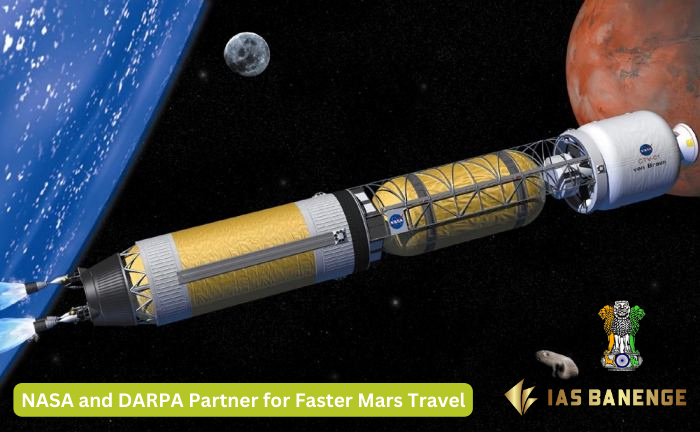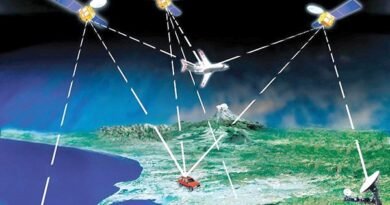NASA and DARPA Partner for Faster Mars Travel |Ias Banenge
”
Context:
In a joint effort, NASA and the United States Defense Advanced Research Projects Agency (DARPA) are actively pursuing the development of a nuclear propulsion system with the potential to halve the duration of travel to Mars. This bold undertaking, titled the Demonstration Rocket for Agile Cislunar Operations (DRACO), is on track for launch in either late 2025 or the early months of 2026.
Relevance:
GS III: Science and Technology (Space agency – NASA , ISRO)
READ MORE – Digital India RISC-V (DIR-V) Program |Ias Banenge
Dimensions of the Article:
- DRACO: Revolutionizing Space Travel through Nuclear Propulsion
- Historical Background of Nuclear Propulsion and DRACO’s Distinctions
- Mars: The Red Planet Unveiled
DRACO: Revolutionizing Space Travel through Nuclear Propulsion
DRACO introduces a paradigm shift in space travel by leveraging nuclear propulsion for enhanced efficiency and reduced travel times between celestial bodies.
Nuclear Reactor Power:
- DRACO centers around a nuclear reactor utilizing energy from uranium atom fission.
- Aims to capitalize on the immense energy generated by nuclear reactions for propulsion.
Transformation of Space Travel:
- Acceleration and Speed Boost: Unlike conventional chemical rockets, nuclear reactions offer significantly greater energy output, enabling continuous acceleration during the journey.
- Shorter Travel Times: DRACO’s accelerated acceleration could drastically reduce travel durations to distant destinations such as Mars.
- Improved Fuel Efficiency: Nuclear propulsion systems require less propellant, leading to enhanced fuel efficiency and decreased travel duration.
Benefits of DRACO:
- Minimized Exposure Risks: Faster travel translates to reduced exposure of astronauts to the hazards of deep space, such as radiation and isolation.
- Mitigation of Health Hazards: Quicker journeys can potentially alleviate health risks associated with prolonged space travel.
Potential Military Applications:
- Versatility Beyond Space Exploration: DARPA’s participation hints at potential terrestrial applications, including rapid maneuvering of military satellites in Earth’s orbit.
Safety Considerations in Nuclear Space Propulsion
Radiation Risks:
- One of the foremost concerns linked to nuclear space propulsion is the possibility of accidents or malfunctions releasing radioactive substances into space or Earth.
- These incidents could result in severe environmental and health repercussions.
Launch Hazards:
- Launching spacecraft with nuclear fuel onboard introduces the risk of launch failures or explosions, potentially dispersing radioactive materials over a wide area.
Historical Background of Nuclear Propulsion and DRACO’s Distinctions
Past Projects:
- Projects such as Orion, Rover, and NERVA previously explored nuclear-powered propulsion systems, though they were not fully realized.
- Project Orion contemplated using atomic bomb detonations for acceleration, while Project NERVA aimed to develop nuclear-thermal engines akin to DRACO.
DRACO’s Advancements:
- Fuel Enrichment: In contrast to Project NERVA’s use of weapons-grade uranium, DRACO employs a less-enriched uranium form, enhancing safety and reducing radioactive material risks.
- In-Space Activation: DRACO’s nuclear reactor remains inactive until reaching space, minimizing chances of radioactive accidents during launch or on Earth.
Mars: The Red Planet Unveiled
Mars, the fourth planet from the Sun in our solar system, is renowned as the “Red Planet” due to its distinctive reddish hue attributed to the presence of iron oxide (rust) on its surface.
READ MORE – NASA Mars Exploration
Atmospheric Composition:
According to NASA
- Mars possesses a thin atmosphere primarily comprising carbon dioxide (95.3%).
- Traces of nitrogen and argon are also found within its atmospheric makeup.
Prominent Surface Features:
- Olympus Mons: This colossal shield volcano is recognized as the largest of its kind in the entire solar system.
- Valles Marineris: A monumental system of canyons etched across the planet’s surface, showcasing the scale of Mars’ geological wonders.
- Polar Ice Caps: Mars bears polar ice caps consisting of water and frozen carbon dioxide (dry ice), representing unique features at its poles.
- Dusty Terrain: The planet’s surface is characterized by a layer of fine dust and scattered rocks, contributing to its distinctive appearance.
Liquid Water and Historical Traces:
- While liquid water is uncommon on Mars today, compelling evidence suggests the occurrence of past liquid flows, offering tantalizing hints of the planet’s ancient hydrological history.
-Source: The Hindu





Pingback: Bill Proposes Modernization of IPC, CrPC, and Evidence Act